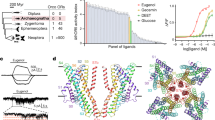Abstract
The olfactory system of Drosophila melanogaster provides a powerful model to study molecular and cellular mechanisms underlying function of a sensory system. In the 1970s Siddiqi and colleagues pioneered the application of genetics to olfactory research and isolated several mutant Drosophila with odorant-specific defects in olfactory behaviour, suggesting that odorants are detected differentially by the olfactory system. Since then basic principles of olfactory system function and development have emerged using Drosophila as a model. Nearly four decades later we can add computational methods to further our understanding of how specific odorants are detected by receptors. Using a comparative approach we identify two categories of short amino acid sequence motifs: ones that are conserved family-wide predominantly in the C-terminal half of most receptors, and ones that are present in receptors that detect a specific odorant, 4-methylphenol, found predominantly in the N-terminal half. The odorant-specific sequence motifs are predictors of phenol detection in Anopheles gambiae and other insects, suggesting they are likely to participate in odorant binding. Conversely, the family-wide motifs are expected to participate in shared functions across all receptors and a mutation in the most conserved motif leads to a reduction in odor response. These findings lay a foundation for investigating functional domains within odorant receptors that can lead to a molecular understanding of odor detection.




Similar content being viewed by others
References
Bailey TL, Boden M, Buske FA, Frith M, Grant CE, Clementi L, Ren J, Li WW, et al. 2009 MEME SUITE: tools for motif discovery and searching. Nucleic Acids Res. 37 W202–W208
Benton R, Sachse S, Michnick SW and Vosshall LB 2006 Atypical membrane topology and heteromeric function of Drosophila odorant receptors in vivo. PLoS Biol. 4 e20
Bohbot J, Pitts RJ, Kwon, HW, Rutzler M, Robertson HM and Zwiebel LJ 2007 Molecular characterization of the Aedes aegypti odorant receptor gene family. Insect Mol. Biol. 16 525–537
Carey AF, Wang G, Su CY, Zwiebel LJ and Carlson JR 2010 Odorant reception in the malaria mosquito Anopheles gambiae. Nature 464 66–71
Dobritsa AA, van der Goes van Naters W, Warr CG, Steinbrecht RA and Carlson JR 2003 Integrating the molecular and cellular basis of odor coding in the Drosophila antenna. Neuron 37 827–841
Engsontia P, Sanderson AP, Cobb M, Walden KK, Robertson HM and Brown S 2008 The red flour beetle's large nose: an expanded odorant receptor gene family in Tribolium castaneum. Insect Biochem. Mol. Biol. 38 387–397
Fox A, Pitts R, Robertson H, Carlson JR and Zwiebel L 2001 Candidate odor receptors from the malaria vector mosquito, Anopheles gambiae. Proc. Natl. Acad. Sci. USA 98 14693–14697
Goldman AL, van der Goes van Naters W, Lessing D, Warr CG and Carlson JR 2005 Coexpression of two functional odor receptors in one neuron. Neuron 45 661–666
Hallem EA and Carlson JR 2004 The odor coding system of Drosophila. Trends Genet. 20 453–459
Hallem EA and Carlson JR 2006 Coding of odors by a receptor repertoire. Cell 125 143–160
Hallem EA, Fox AN, Zwiebel LJ and Carlson JR 2004a Mosquito receptor for human-sweat odorant. Nature 427 212–213
Hallem EA, Ho MG and Carlson JR 2004b The molecular basis of odor coding in the Drosophila antenna. Cell 117 965–979
Hill CA, Fox AN, Pitts RJ, Kent LB, Tan PL, Chrystal, MA, Cravchik A, Collins FH, et al. 2002 G protein-coupled receptors in Anopheles gambiae. Science 298 176–178
Kreher SA, Mathew D, Kim, J and Carlson JR 2008 Translation of sensory input into behavioral output via an olfactory system. Neuron 59 110–124
Larsson MC, Domingos AI, Jones WD, Chiappe ME, Amrein H and Vosshall LB 2004 Or83b encodes a broadly expressed odorant receptor essential for Drosophila olfaction. Neuron 43 703–714
Mathew D, Martelli C, Kelley-Swift E, Brusalis C, Gershow M, Samuel AD, Emonet T and Carlson JR 2013 Functional diversity among sensory receptors in a Drosophila olfactory circuit. Proc. Natl. Acad. Sci. USA 110 E2134–2143
Nakagawa T, Pellegrino M, Sato K, Vosshall LB and Touhara K 2012 Amino acid residues contributing to function of the heteromeric insect olfactory receptor complex. PLoS ONE 7 e32372
Neuhaus EM, Gisselmann G, Zhang W, Dooley R, Stortkuhl K and Hatt H 2005. Odorant receptor heterodimerization in the olfactory system of Drosophila melanogaster. Nat. Neurosci. 8 15–17
Robertson HM and Wanner KW 2006 The chemoreceptor superfamily in the honey bee, Apis mellifera: expansion of the odorant, but not gustatory, receptor family. Genome Res. 16 1395–1403
Sato K, Pellegrino M, Nakagawa T, Vosshall LB and Touhara K 2008 Insect olfactory receptors are heteromeric ligand-gated ion channels. Nature 452 1002–1006
Su CY, Menuz K and Carlson JR 2009 Olfactory perception: receptors, cells, and circuits. Cell 139 45–59
Vosshall LB and Stocker RF 2007 Molecular architecture of smell and taste in Drosophila. Annu. Rev. Neurosci. 30 505–533
Wang G, Carey AF, Carlson JR and Zwiebel LJ 2010 Molecular basis of odor coding in the malaria vector mosquito Anopheles gambiae. Proc. Natl. Acad. Sci. USA 107 4418–4423
Wanner KW, Anderson AR, Trowell SC, Theilmann DA, Robertson HM and Newcomb RD 2007 Female-biased expression of odourant receptor genes in the adult antennae of the silkworm, Bombyx mori. Insect Mol. Biol. 16 107–119
Wilson RI 2013 Early olfactory processing in Drosophila: mechanisms and principles. Annu. Rev. Neurosci. 36 217–241
Author information
Authors and Affiliations
Corresponding author
Additional information
[Ray A, van Naters WG and Carlson JR 2014 Molecular determinants of odorant receptor function in insects. J. Biosci. 39 1–9] DOI 10.1007/s12038-014-9447-7
Supplementary materials pertaining to this article are available on the Journal of Biosciences Website at http://www.ias.ac.in/jbiosci/sep2014/supp/Ray.pdf
Electronic supplementary material
Below is the link to the electronic supplementary material.
ESM 1
(PDF 1.13 mb)
Rights and permissions
About this article
Cite this article
Ray, A., van der Goes van Naters, W. & Carlson, J.R. Molecular determinants of odorant receptor function in insects. J Biosci 39, 555–563 (2014). https://doi.org/10.1007/s12038-014-9447-7
Published:
Issue Date:
DOI: https://doi.org/10.1007/s12038-014-9447-7




